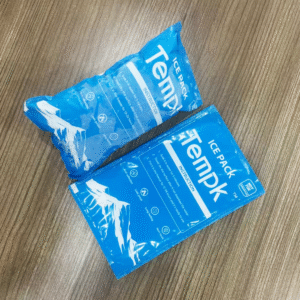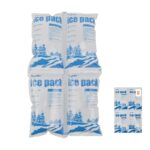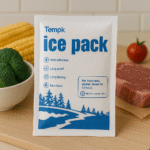Packing dry ice for transport requires careful planning and execution to ensure both safety and effectiveness. Trockeneis, solidified carbon dioxide (CO2), is ideal for keeping temperature-sensitive items frozen. Jedoch, improper handling or insufficient insulation can lead to a range of problems, including rapid sublimation, product spoilage, or safety risks. This guide provides expert advice on how to pack dry ice securely for safe transport, ensuring your goods remain frozen during transit without compromising safety or efficiency.
-
Why is it important to pack dry ice properly?
-
What materials are best for packing dry ice effectively?
-
What precautions should you take when handling dry ice during transport?
-
How can you ensure your dry ice stays effective throughout the journey?
Why Is It Important to Pack Dry Ice Properly?
Packing dry ice correctly ensures that it maintains its freezing power for as long as possible while minimizing risks associated with CO2 gas buildup. Dry ice sublimates directly from solid to gas, making it incredibly cold and effective in preserving temperature-sensitive products. Jedoch, without proper packaging, dry ice can sublimate too quickly, which leads to rapid loss of effectiveness.
Ensuring the right insulation and ventilation helps maintain a stable temperature inside your container and avoids dangerous CO2 gas buildup. Unchecked CO2 buildup can pose serious risks in confined spaces, such as transport vehicles or storage units, where air circulation is restricted.
Key Benefits of Proper Dry Ice Packing:
-
Prevents rapid sublimation: Keeps dry ice solid for longer, preserving the frozen state of your goods.
-
Minimizes CO2 buildup: Ventilated containers prevent CO2 accumulation, reducing the risk of asphyxiation.
-
Optimizes temperature management: Proper packing maintains the correct freezing temperature, ensuring perishable items remain safe.
What Are the Best Materials for Packing Dry Ice?
Choosing the right materials for packing dry ice is crucial for maintaining both its freezing power and safety during transport. Below are the most common materials used for packing dry ice efficiently:
-
Styrofoam Coolers: These are lightweight yet provide excellent insulation, keeping dry ice solid for extended periods. Their structure offers effective protection from external heat.
-
Double-Walled Cardboard Boxes: These offer good protection and help insulate the contents. When combined with Styrofoam or foam inserts, they provide a solid solution for dry ice packing.
-
Isolierte Behälter: Many cold chain companies use pre-designed insulated containers with built-in safety features and temperature control systems. These containers help maintain stable temperatures for sensitive goods during extended journeys.
How Do You Ensure Dry Ice Remains Effective During Transit?
To ensure dry ice stays solid throughout the transport process, the following strategies are recommended:
1. Use Thick Insulation Materials
Thick, high-quality insulation materials like Styrofoam or reflective bubble wrap slow down the sublimation process and prevent excessive heat from reaching the dry ice.
2. Seal Containers Tightly
Seal your container as tightly as possible to minimize airflow, but always ensure there’s proper ventilation to allow CO2 gas to escape. This will prevent the gas from building up inside the container and causing potential pressure-related hazards.
3. Maintain Proper Temperature in the Shipping Area
Ensure that the environment around the dry ice remains cool. Shipping in extreme heat or leaving the container in direct sunlight can speed up the sublimation process, reducing the effectiveness of the dry ice.
Key Precautions When Handling Dry Ice
Dry ice requires careful handling due to its extreme cold temperatures and the risks associated with CO2 buildup. Here are the essential precautions to follow when packing dry ice for transport:
1. Wear Proper Protective Gear
Always use insulated gloves when handling dry ice. Direct contact with skin can cause severe frostbite. If using tongs, ensure they are designed for handling extremely cold materials.
2. Ventilate Containers
Ensure that your packing container allows for proper ventilation. CO2 gas can quickly accumulate in sealed containers, posing a risk of explosion or asphyxiation. Always use containers with vented lids or perforated areas.
3. Avoid Sealing Dry Ice in Airtight Containers
Sealing dry ice in an airtight container is a safety hazard. As it sublimates, it releases CO2 gas, which can cause the container to explode under pressure. Always allow gas to escape safely.
4. Ensure Good Ventilation During Transport
When transporting dry ice in a vehicle, keep windows cracked open or use proper ventilation systems to allow CO2 to disperse. This ensures that you avoid dangerous CO2 buildup inside the car.
How Long Does Dry Ice Last in Transit?
The longevity of dry ice depends on various factors such as the type of container used, the amount of dry ice, und die Umgebungstemperatur. On average, dry ice lasts around 18-24 hours in well-insulated containers. For longer durations, additional dry ice may be required or you may need to consider a temperature-controlled shipping service.
How to Pack Dry Ice Safely: A Step-by-Step Process
-
Choose the Right Packaging Materials
Use an insulated container, such as a Styrofoam cooler or an insulated shipping box. Line the container with a reflective insulating material to enhance performance. -
Place Dry Ice at the Bottom
Position the dry ice at the bottom of the cooler, ensuring it is not in direct contact with any items. This helps prevent rapid sublimation from external warmth. -
Fill with Insulating Materials
After placing the dry ice, fill the remaining space with insulating materials like foam peanuts, bubble wrap, or packing paper. This further reduces the airflow and helps maintain temperature stability. -
Ensure Ventilation
Use a vented lid or leave gaps in your container to allow CO2 to escape safely. Avoid tightly sealing the container to reduce the risk of pressure buildup.
Trends in Dry Ice Packing for 2025
The cold chain logistics industry is evolving rapidly, and the use of dry ice is adapting accordingly. Here are the key trends in dry ice packaging for 2025:
-
Smart Containers with Temperature Sensors: Advanced containers equipped with real-time temperature tracking sensors are becoming increasingly common. These devices send alerts to shippers, ensuring temperature-sensitive products remain within the required temperature range.
-
Umweltfreundliche Materialien: There is growing interest in sustainable packaging options that reduce the environmental impact of dry ice transport. Companies are moving towards biodegradable and recyclable insulation materials.
-
Automation in Cold Chain Monitoring: Automation tools are being integrated into the shipping process, allowing companies to monitor dry ice levels and temperature data remotely, reducing the potential for human error.
FAQ – Frequently Asked Questions
Q1: Can I pack dry ice with food?
Ja, you can pack dry ice with food, but make sure to keep the dry ice separated from direct contact with food items. Use insulating materials like foam or paper to prevent moisture buildup.
Q2: How much dry ice do I need for shipping?
The amount of dry ice required depends on the shipping duration and the size of the cooler. Allgemein, you will need 1-2 pounds of dry ice per 24-hour period for small shipments, while larger shipments may require more.
Abschluss
Packing dry ice for transport is a critical process that ensures perishable goods remain safe during transit. By using the right materials, following safety precautions, and ensuring proper ventilation, you can effectively extend the shelf life of temperature-sensitive items. Für 2025, staying updated with the latest trends and advancements in dry ice technology will help optimize your cold chain logistics and improve the safety and efficiency of your shipments.
Über Tempk
Tempk is a leading provider of cold chain solutions, specializing in advanced insulated containers and packaging options designed to maintain optimal conditions during transport. Our high-quality products ensure that your dry ice stays effective, keeping your shipments at the right temperature for longer periods.
























